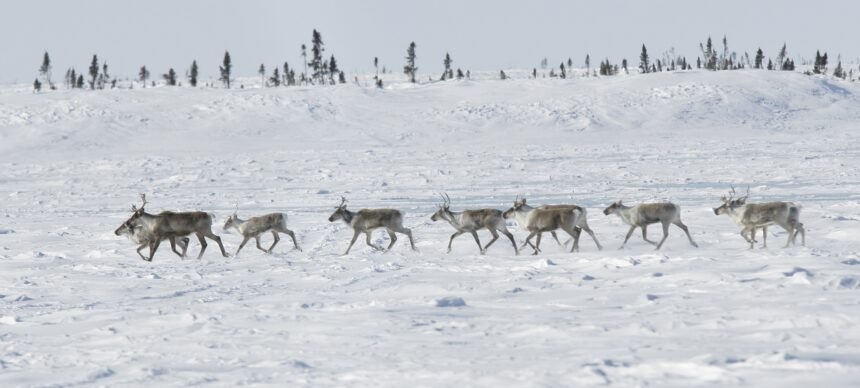The light scatters differently across the snow in this part of the Northwest Territories. I’ve visited many northern communities over the years, but the crystalline quality of Arctic winter sunshine still catches me by surprise each time. Standing beside Mabel Firth, a 73-year-old Gwich’in elder who’s been tracking caribou migration patterns since she was a child, I’m humbled by the vastness of the tundra stretching before us.
“The caribou have always shown us the way,” Mabel tells me, her breath clouding in the -30°C air. “But the paths they follow now aren’t the same as when my grandmother taught me. The land is changing faster than our stories can keep up.”
It’s this rapidly shifting Arctic landscape that has brought together an unlikely coalition of Indigenous knowledge keepers, climate scientists, and artificial intelligence experts in what might be one of the most promising conservation partnerships in Canada’s North.
The Porcupine caribou herd, whose annual migration spans more than 2,400 kilometers across Alaska, Yukon and the Northwest Territories, faces unprecedented challenges. Climate change has altered vegetation patterns, introduced new predators, and created unstable ice conditions that disrupt traditional routes. Meanwhile, industrial development threatens crucial calving grounds.
“We’re witnessing climate change at nearly three times the global rate here in the Arctic,” explains Dr. Sonia Zhang, a climatologist with Environment and Climate Change Canada who has been monitoring temperature variations across the region for a decade. “What used to be predictable seasonal changes have become erratic and extreme.”
This unpredictability poses an existential threat to the caribou—and by extension, to the fourteen Indigenous communities whose cultural identity and food security have been intertwined with these animals for thousands of years.
Enter the Northern Migration Project, an innovative conservation initiative that pairs traditional ecological knowledge with advanced machine learning algorithms to protect caribou movement corridors in real time.
“We’re not replacing traditional knowledge—we’re amplifying it,” explains Darren Nasogaluak, a Inuvialuit software engineer who helped design the AI system. “The elders tell us what to look for, and the technology helps us see it across a much wider area than human observers could monitor alone.”
The system works by integrating multiple data streams: satellite imagery tracking snow depth and vegetation changes, weather station measurements, wildlife camera footage, and perhaps most crucially, observations from Indigenous land users who report conditions through a specialized app available in four languages including Gwich’in and Inuvialuktun.
Machine learning algorithms process this information to identify emerging obstacles to caribou movement and predict alternative pathways the herds might follow. These insights allow communities and conservation authorities to make informed decisions about land use, hunting practices, and emergency interventions when needed.
“Last winter, the system identified a dangerous ice buildup along a key river crossing two weeks before the caribou were expected to arrive,” recalls Michael Francis, a wildlife technician with the Vuntut Gwitchin Government. “We were able to establish alternative crossing points with packed snow trails. Without that early warning, we might have lost dozens of animals to drowning or injury.”
The technology has also proven valuable in mitigating human-caused disruptions. When mining exploration threatened to intersect with a newly established migration corridor last year, data from the AI system provided evidence that helped secure an emergency protection order under the Species at Risk Act.
While the technological aspects are impressive, the true innovation lies in how the project has been structured to center Indigenous governance. Unlike past conservation efforts that often treated northern communities as subjects rather than leaders, the Northern Migration Project operates under a framework of Indigenous data sovereignty.
“Every byte of information belongs to the people whose land it comes from,” explains Dr. Lisa Qiluqqi Koperqualuk, president of Inuit Circumpolar Council Canada and a key architect of the project’s governance model. “The technology serves the communities, not the other way around.”
This commitment extends to how the AI itself functions. The machine learning models have been carefully designed to incorporate Inuit Qaujimajatuqangit (Inuit traditional knowledge) and Gwich’in understandings of caribou behavior as foundational rather than supplementary inputs.
“Western science tends to separate things into categories—habitat, climate, animals, people,” observes Jacob Snowshoe, a Tetlit Gwich’in knowledge keeper who serves on the project’s steering committee. “Our knowledge doesn’t work that way. We see the connections between all things. The AI had to be taught to think more holistically to be truly useful here.”
Not everyone has embraced the technological intervention. Some elders expressed initial skepticism about introducing complex algorithms into traditional wildlife management practices.
“I was against it at first,” admits Peter Ross, a hunter from Fort McPherson. “I thought, ‘We’ve managed without computers for generations, why start now?’ But when I saw how it was helping younger people connect with the land and make good decisions about when and where to hunt, I changed my mind.”
The early results are promising. Since the system’s implementation three years ago, calf survival rates have increased by 8 percent according to data from Environment and Climate Change Canada. Communities report greater hunting success with less effort, an important factor as fuel prices in northern communities continue to rise.
But the project faces significant challenges. Reliable internet connectivity remains spotty across much of the region, limiting real-time data collection. The sophisticated technology requires ongoing maintenance and updates, raising questions about long-term sustainability once initial funding from the federal government’s Climate Action and Awareness Fund expires next year.
Perhaps most concerning is the ethical question that haunts many conservation technologies: at what point does intervention become interference with natural processes?
“We’re walking a fine line,” acknowledges Dr. Zhang. “We want to help the caribou adapt to human-caused changes without making them dependent on human management. The goal is to give them space to find their own way forward.”
As the Arctic continues to warm and transform, the lessons from this innovative approach to wildlife conservation may prove valuable far beyond caribou management. Similar systems are already being considered for monitoring polar bear denning sites and beluga whale migration in Hudson Bay.
Back on the tundra with Mabel, I watch as she opens the project’s app on her phone—a striking juxtaposition of ancient knowledge and cutting-edge technology in her weathered hands. She points to a digital map showing the predicted movement of the herd over the coming weeks, then gestures toward the distant horizon.
“The machines are learning to read the land,” she says with a slight smile. “But we still need to teach them to listen to it.”
In this rapidly changing Arctic, that might be the most important lesson of all.






